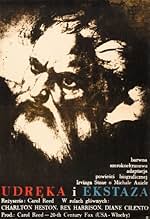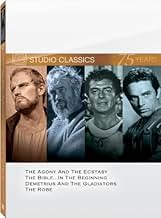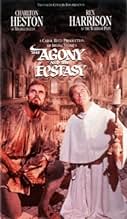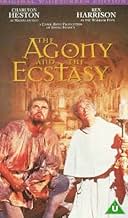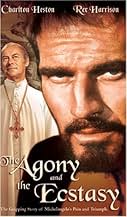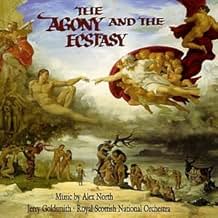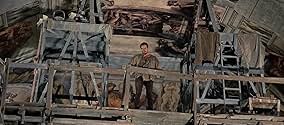VALUTAZIONE IMDb
7,2/10
8580
LA TUA VALUTAZIONE
La vita e i guai di Michelangelo mentre dipingeva la Cappella Sistina su sollecitazione di papa Giulio II.La vita e i guai di Michelangelo mentre dipingeva la Cappella Sistina su sollecitazione di papa Giulio II.La vita e i guai di Michelangelo mentre dipingeva la Cappella Sistina su sollecitazione di papa Giulio II.
- Candidato a 5 Oscar
- 3 vittorie e 9 candidature totali
Fortunato Arena
- Pope's Bodyguard
- (non citato nei titoli originali)
Lars Bloch
- Baron Von Silenen
- (non citato nei titoli originali)
Angelo Boscariol
- Papal Guard
- (non citato nei titoli originali)
Calisto Calisti
- Physician
- (non citato nei titoli originali)
Amerigo Castrighella
- Quarry cart assistant
- (non citato nei titoli originali)
Anita Ceccotti
- Woman Under the Chapel
- (non citato nei titoli originali)
Enrico Chiappafreddo
- Tavern Customer
- (non citato nei titoli originali)
Recensioni in evidenza
This is a fascinating, colorful and very-well made film that looks like an epic and is in fact an intelligent drama about sculptor-painter- architect-poet Michelangelo Buonarrotti. Here portrayed by the much taller Charlton Heston, and admirably, he is presented as a man who want only to create beauty, a man without "people skills" or interest in much of anything else--not women, nor war not the dynastic dreams of men--only the Renaissance idea of utilizing one's abilities. He even pays attention to religion only because the world interests him, and he equates his heaven with what men can achieve--and Earth with the same sort of place he expects to find as an afterlife. Carol Reed directed and produced this fascinating look at the Renaissance, with its warrior priests, its worldly dreamers and its subtle change toward a politics of gunpowder, secular pursuits and worldly morality. Philp Dunne, author of "David and Bathsheba" wrote this thoughtful spectacle film as well. In the cast besides Heston are Rex Harrison as Pope Julius, close-fisted patron, admirer and nemesis, Harry Andrews as his rival Bramante, Diane Cilento as the woman who would like to love him, Alberto Lupo, Adolfo Celli, Fausto Tozzi and a narration by Marvin Miller. The opportunity to see the real landscapes in which Michelangelo was born, worked and became inspired is a wonderful one for the viewer; the entire Carrara marble quarry section is stunningly beautiful. The film has battle scenes able done by Robert D. Webb, Leon Shamroy's cinematography, a prelude by Jerrald Goldsmith and sterling music by Alex North, production design by John Cuir and Jack Martin Smith and memorable costumes by Vittorio Nino Novarese. The basic thrust of the storyline is twofold; against the wars conducted by vigorous and all-too-worldly Pope Julius, the war to win secular hegemony for his Papal rule, the counter-current is Michelangelo's desire to further his career in Rome by obtaining a commission from the Pope. He does, an assignment to refurbish the Sistine Chapel for him. But after an attempt at some saints, he leaves Rome, and flees to his beloved Carrara. There, surrounded by mountains, he has a vision at sunset and suddenly knows what he must do. Obtaining Julius's reluctant permission, he sets to work covering that modest ceiling with tremendous figures, a bearded Jehovah, a recumbent Adam touched to life by a divine spark, the world's most famous fresco painted from a homemade scaffolding; in spite of illness, missed meals, filth, deprivation, cold, an injury that nearly costs him his eye and more, including the Pope's indifference to his intense passion for his art, Michelangelo endures. "When will you make an end?" Julius cries. "When I have done," the artist insists. And at the end, Julius, beaten on the field of battle, admits he may also have been wrong about the ceiling...that his fostering of Michelangelo's work may be the most important thing he has ever done. Of course the puritans of the era object to the nakedness the artist has depicted, but Michelangelo says he painted people as God made them. The movie, based on the biography "The Agony and the Ecstacy" by Irving Stone here concentrates on a seminal moment in the great artist's career. He may be a sculptor as he insists; but after seeing this moving and fascinating film, no one can doubt that he is also a stubborn and single-minded man--and a painter of genius. Most underrated; often fascinating fictionalized biography. Heston and Harrison are good, everyone else good as well. Worth seeing many times, if only for Dunne's dialogue and the scenery.
I like historical films. Recently I watched three historical films all made in the early 1960s. These are 'El Cid', 'The Spartacus' and 'The Agony and The Ecstasy'. Of the three, I rate The Agony and the Ecstasy as the best. This film is based on the eponymous novel written by Irving Stone. I had read the book nearly a decade back and it was nice to see the film finally. The film is about the circumstances under which Michelangelo came to compose his famous frescoes in the Sistine Chapel of Rome in the 16th century. The Sistine fresco, the 'creation of man' has become almost an emblem for the artist. But not many know that Michelangelo painted the Sistine frescoes reluctantly, only because he was forced to do so by his patron, Pope Julius II. The film is about the war of wits between these two great men Pope Julius II is a warrior pope, a worldly Pope. His concern is to protect the papal states from being over run by warring European powers. For this he is willing to take up arms. The pope knows that the posterity wont remember him for his spiritual prowess or leadership. Therefore he want to leave great works of art as his legacy. He therefore hires Michelangelo to paint the ceiling of the Sistine Chapel. The artist is not very keen on painting and considers sculpture to be his true calling. He is also not willing to conform to the prevailing canons of artistic excellence. He feels constrained by the limits of time and money that is set. All the great moments of the film occur when the Pope and the Artist clash. It is a clash of ideas and world views: (1) Whether sculpture is a superior form of art as compared to painting; (2) Whether it is appropriate depict biblical figures in their raw humanity; (3) Whether it is moral for a man of god to take arms for his principles and so on. For me the finest scene in the film is where the Pope and the Cardinals come to see the frescoes and judge it as lacking in good taste. The Artist is forced to give a strong rebuttal and in the process he expounds the humanist philosophy of art. Shot in beautiful Technicolor, the film still looks spectacular. It is a visual and intellectual treat.
The Agony and the Ecstasy is the story of the creation of the Sistine Chapel Roof painting, the time and money it took while Pope Julius II was busy establishing his Papacy as a political force.
Back in those days the Pope was far more than the head of the Roman Catholic Church. He ruled a considerable piece of real estate in the center of the Italian peninsula that were called the Papal States. They varied in geographic size depending on how relatively strong the Pope or his enemies were at a given time. The Papal States were the last independent entity to join a united Italy in 1870.
The Borgias had been nibbling away at the Papal States for years and their triumph became complete when one of their's became Pope Alexander VI in 1491. When Giuliano Della Rovere became Julius II in 1503 succeeding Alexander VI he had it in mind to reclaim the states from the Borgias and their backer the French monarchy. Those are the folks you see Rex Harrison fighting at the beginning of the film.
In fact Harrison's identity as the warrior Pope is made clear right at the beginning of the film when after we see this figure on a white horse killing some foes in battle, he takes off his helmet and some attendees put his papal vestments right over his armor.
But Julius II wanted to be known as a patron of the arts as well as the warrior Pope. His uncle Pope Sixtus VI had built the Sistine Chapel which is today the personal chapel of the papal residence. According to Wikipedia its dimensions are exactly what the Bible lays down as the dimensions King Solomon built his temple. But who knows what Solomon had decorating his roof.
It's a big bare spot and who to fill it with something good. Julius II decided on Michelangelo Buonarrati who's got quite a resume of creativity to recommend him even though it's mostly sculpture.
The film is the story of the creative differences between Michelangelo and Julius. Michelangelo is knowing he's created something for the ages, but he won't see the big picture of the here and now of Renaissance European politics which Julius II has to deal with.
Sir Carol Reed directed The Agony and the Ecstasy and does a marvelous job of creating the look and atmosphere of the Renaissance in Italy. Charlton Heston and Rex Harrison playing Michelangelo and the Pope give outstanding performances.
If the film has a weakness is that it really is a two man show with no other characters developed in any way. The rest of the mostly Italian cast just serve as a crowd.
If you're either a patron of the arts or a Catholic who would like to know how the Sistine Chapel acquired its legendary roof than by all means see The Agony and the Ecstasy.
Back in those days the Pope was far more than the head of the Roman Catholic Church. He ruled a considerable piece of real estate in the center of the Italian peninsula that were called the Papal States. They varied in geographic size depending on how relatively strong the Pope or his enemies were at a given time. The Papal States were the last independent entity to join a united Italy in 1870.
The Borgias had been nibbling away at the Papal States for years and their triumph became complete when one of their's became Pope Alexander VI in 1491. When Giuliano Della Rovere became Julius II in 1503 succeeding Alexander VI he had it in mind to reclaim the states from the Borgias and their backer the French monarchy. Those are the folks you see Rex Harrison fighting at the beginning of the film.
In fact Harrison's identity as the warrior Pope is made clear right at the beginning of the film when after we see this figure on a white horse killing some foes in battle, he takes off his helmet and some attendees put his papal vestments right over his armor.
But Julius II wanted to be known as a patron of the arts as well as the warrior Pope. His uncle Pope Sixtus VI had built the Sistine Chapel which is today the personal chapel of the papal residence. According to Wikipedia its dimensions are exactly what the Bible lays down as the dimensions King Solomon built his temple. But who knows what Solomon had decorating his roof.
It's a big bare spot and who to fill it with something good. Julius II decided on Michelangelo Buonarrati who's got quite a resume of creativity to recommend him even though it's mostly sculpture.
The film is the story of the creative differences between Michelangelo and Julius. Michelangelo is knowing he's created something for the ages, but he won't see the big picture of the here and now of Renaissance European politics which Julius II has to deal with.
Sir Carol Reed directed The Agony and the Ecstasy and does a marvelous job of creating the look and atmosphere of the Renaissance in Italy. Charlton Heston and Rex Harrison playing Michelangelo and the Pope give outstanding performances.
If the film has a weakness is that it really is a two man show with no other characters developed in any way. The rest of the mostly Italian cast just serve as a crowd.
If you're either a patron of the arts or a Catholic who would like to know how the Sistine Chapel acquired its legendary roof than by all means see The Agony and the Ecstasy.
like many historical films from the same age of Hollywood, the word "impressive" is the first to say. not only for its status of epic drama, costumes and the translation in image of a period. but, maybe , more important, for the admirable clash between Rex Harrison and Charlton Heston. and for the feel than a great story has its right and fair adaptation. because something impose "The Agony and the Ectasy" as special. not the biography of a great artist - and the admirable virtue is to know than Heston is Michelangelo not only act him - but the chance to discover yourself. the film, like the book, it is a beautiful eulogy to the life. using a genius as character of a kind of parable about art, proud, honesty and desire. so, just impressive. in this case - a word with deep roots.
The picture deals with Michelangelo or Michael Angel (Charlton Heston) who is working on the Carrara's marble creating sculptures and he is then ordered by Pope Julius II (Rex Harrison) the painting of as called Sistine chapel (that's why it was built by Pope Sisto) . Meanwhile , they'll develop various relationships with other Renaissance's important people . The film is correctly based on historical deeds and appearing famous roles , such as : Raphael (Tomas Milian) who shows up painting the ¨Athenas' school¨, Bramante (Harry Andrews) builder of the Vatican dome that hold his name , Girlandaio , Florence Medicis' descendants (Diane Cilento and Adolfo Celi) and duke of Urbin (Alberto Lupo). Besides , the film paces itself the confrontation between Julius II troops and the French/German army for the possession of the Pope's states . There are epic and impressive battles where the Pope himself fights enemies . The motion picture describes specially the creation of the enormous paintings on the ceiling and the difficulties that Michael Angel is suffering to achieve the immortal legacy . The Pope Julio II will also assign him the realization of his tomb .
The feature movie obtained a limited success and had a moderated box-office ; however , being nowadays better valued than the past . First-range acting by the two main actors : Charlton Heston and Rex Harrison , both of whom are magnificent . However , Rex Harrison did not get along with Charlton Heston at all during shooting ; in fact , twelve years later, while filming as secondary actors ¨Crossed swords¨ (1977) directed by Richard Fleischer , Rex avoided him utterly . Leon Shamroy's cinematography is rousing , the colorful paintings are glowing and brilliant ; spectacularly showing Bible's scenes at the Sistine Chapel . Alex North musical score is riveting (like ¨Spartacus¨ who he equally composed) . The sets are overwhelming and breathtaking , they were stunningly designed by production designer John De Cuir . In addition , evocative as well as adequate costumes by Oscarized Vittorio Nino Novarese . Carol Reed production and direction were excellent , he'd got much experience through a long career and had directed other classic movies (The third man) . Rating: Very good , above average and well worth seeing.
The feature movie obtained a limited success and had a moderated box-office ; however , being nowadays better valued than the past . First-range acting by the two main actors : Charlton Heston and Rex Harrison , both of whom are magnificent . However , Rex Harrison did not get along with Charlton Heston at all during shooting ; in fact , twelve years later, while filming as secondary actors ¨Crossed swords¨ (1977) directed by Richard Fleischer , Rex avoided him utterly . Leon Shamroy's cinematography is rousing , the colorful paintings are glowing and brilliant ; spectacularly showing Bible's scenes at the Sistine Chapel . Alex North musical score is riveting (like ¨Spartacus¨ who he equally composed) . The sets are overwhelming and breathtaking , they were stunningly designed by production designer John De Cuir . In addition , evocative as well as adequate costumes by Oscarized Vittorio Nino Novarese . Carol Reed production and direction were excellent , he'd got much experience through a long career and had directed other classic movies (The third man) . Rating: Very good , above average and well worth seeing.
Lo sapevi?
- QuizThe book on which this movie is based covers the entire life of Michelangelo Buonarroti. This movie based on a single chapter. One of the shortest, if not the shortest, in the entire book.
- BlooperAs shown in the movie, Michelangelo created a flat wooden platform on brackets built out from holes in the wall, high up near the top of the windows. But contrary to what is depicted in the film, he did not lie on this scaffolding while he painted, but painted from a standing position.
- ConnessioniEdited from Prologue: The Artist Who Did Not Want to Paint (1965)
I più visti
Accedi per valutare e creare un elenco di titoli salvati per ottenere consigli personalizzati
- How long is The Agony and the Ecstasy?Powered by Alexa
Dettagli
- Data di uscita
- Paese di origine
- Lingue
- Celebre anche come
- La agonía y el éxtasis
- Luoghi delle riprese
- Piazza del Popolo, Todi, Perugia, Umbria, Italia(St. Peter's Square scene)
- Azienda produttrice
- Vedi altri crediti dell’azienda su IMDbPro
Botteghino
- Budget
- 10.000.000 USD (previsto)
- Tempo di esecuzione
- 2h 18min(138 min)
- Colore
- Proporzioni
- 2.20 : 1
Contribuisci a questa pagina
Suggerisci una modifica o aggiungi i contenuti mancanti


